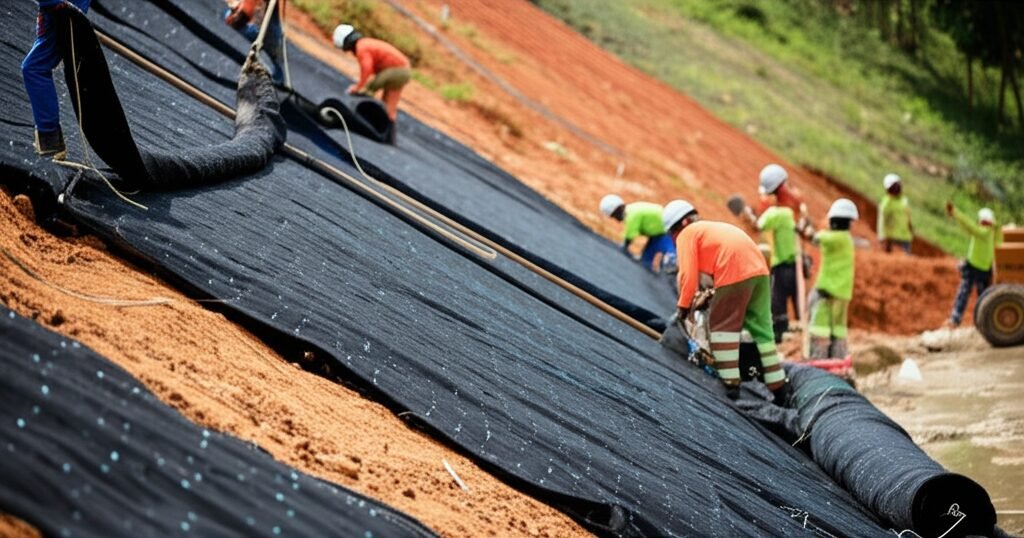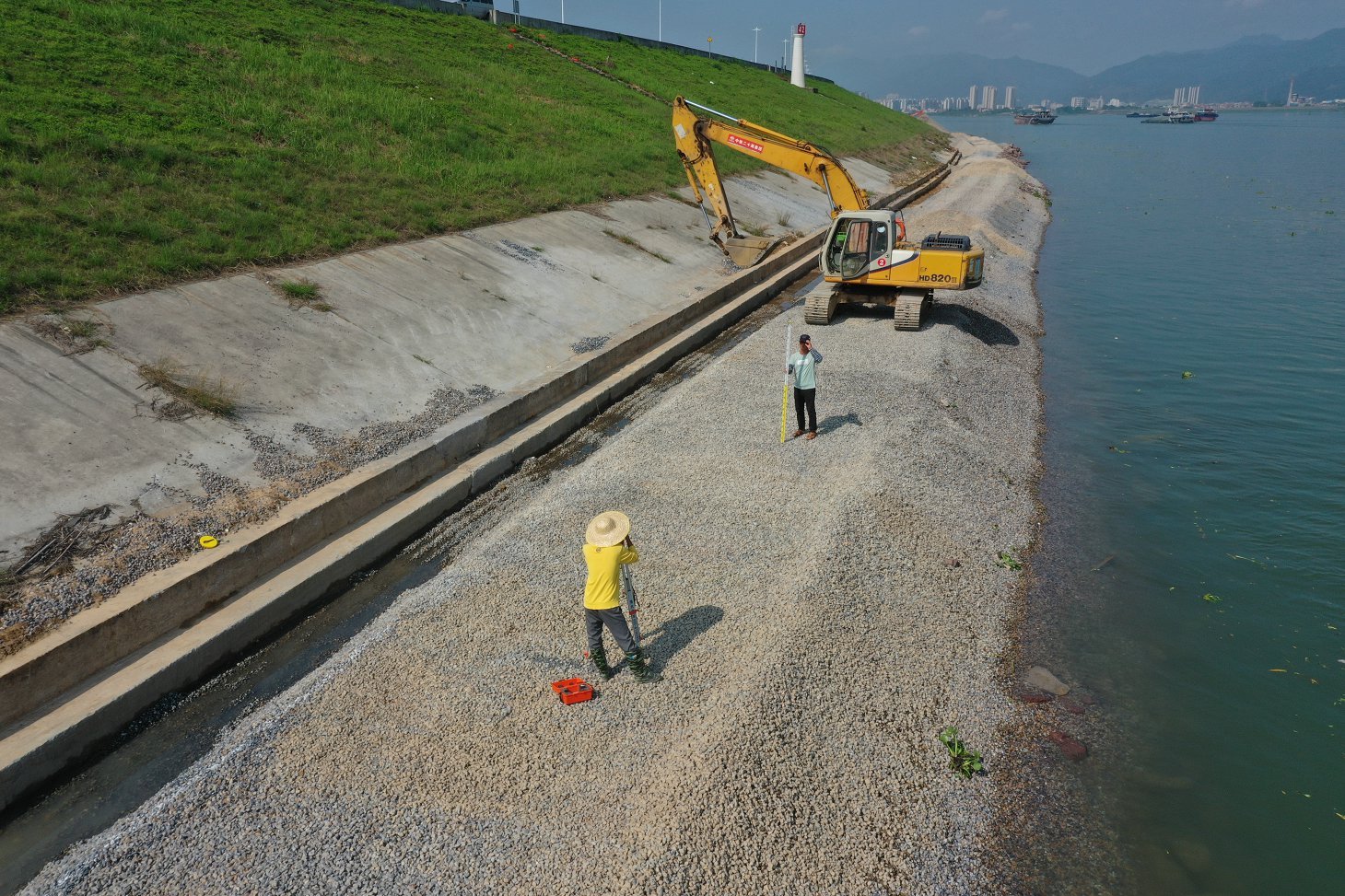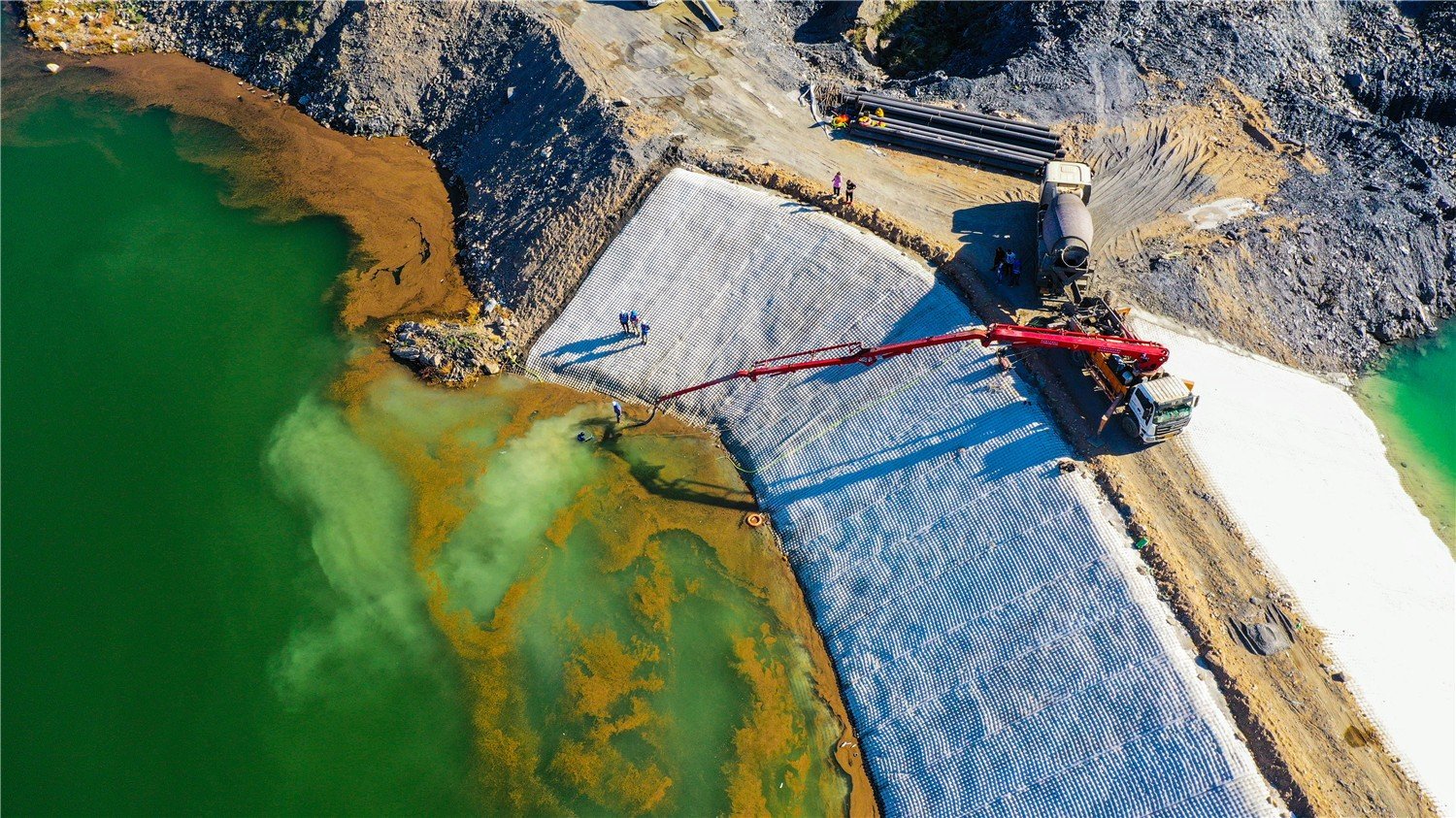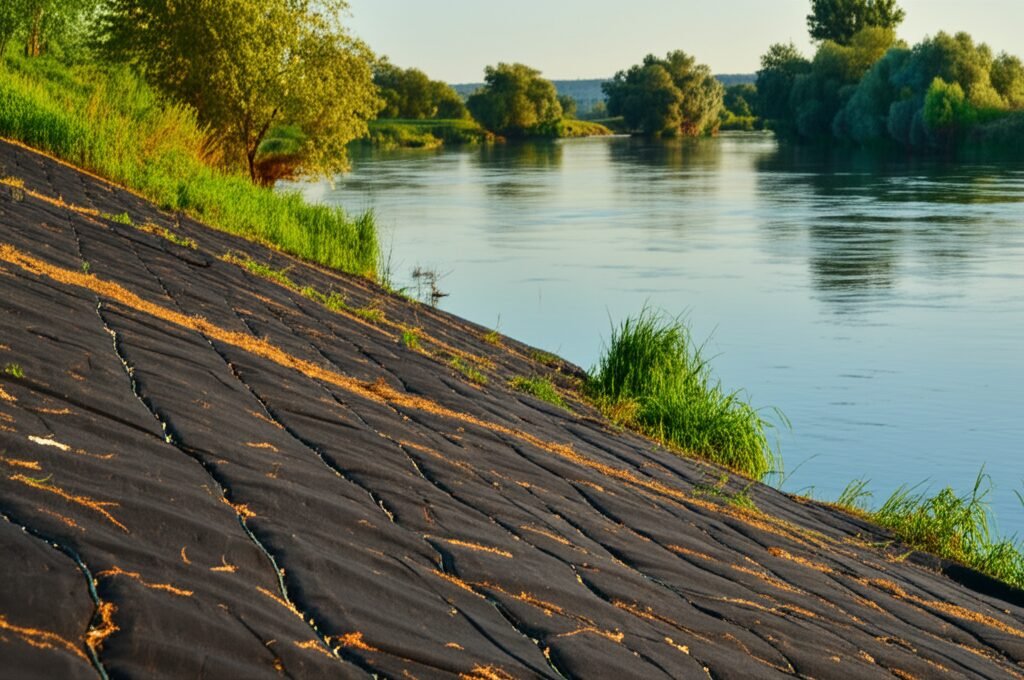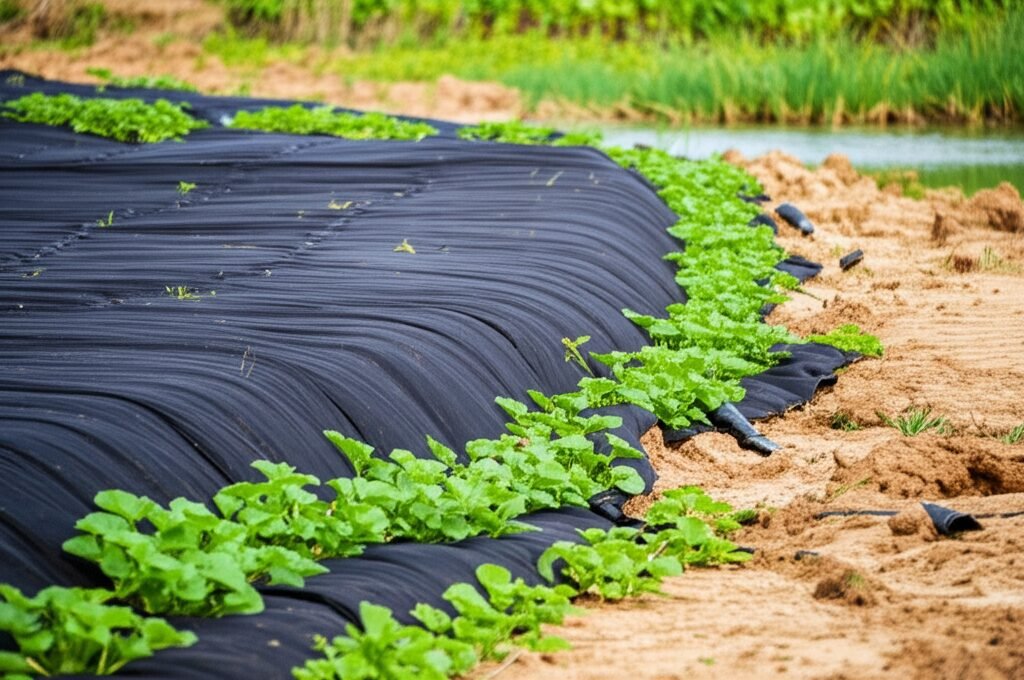Geotextile Mattresses for Slope Stabilization: Case Studies & Erosion Control Methods
Okay, here are some key things to know about using geotextile mattresses for stabilising slopes, based on real projects:
Key Takeaways:
- Geotextile mattresses are effective for controlling erosion on riverbanks, highway embankments, coastlines, and steep slopes.
- They work by providing a stable, confined layer that prevents soil washing away.
- These mattresses can be filled with grout or soil, and sometimes seeded to encourage vegetation growth.
- Vegetation helps alot with long-term stability and makes the slope look more natural.
- Proper site assessment and installation are super important for them to work right.
- They offer a durable alternative to traditional methods like riprap, especially in challenging conditions.
- Case studies show they protect infrastructure and property from erosion damage effectively.
What Are Geotextile Mattresses and How Do They Stabilize Slopes?
So, what exactly are we talkin’ about with these geotextile mattresses? Basically, they’re like engineered fabric bags, or envelopes, made from strong synthetic textiles. Think of ’em as large, flat containers. You lay these out on a slope that’s having erosion problems. The idea is pretty simple but effective. The fabric itself holds the soil or fill material in place, stopping it from getting washed away by rain or flowing water. They are designed with specific pore sizes, ya know, so water can seep through slowly, which is important. This prevents water pressure building up behind the mattress, which could otherwise cause the whole slope to fail. Pressure release is key. We often fill these mattresses with concrete grout, sand, or sometimes just local soil depending on the job. When filled, they form a heavy, flexible mat that kinda moulds itself to the shape of the slope. This makes them really good for uneven ground where rigid structures wouldnt work so well.
Their main job is erosion control. Slopes, especially bare ones or those next to water, are always under attack from weather. Rain hammers down, water flows over the surface, and it starts carrying soil particles away. Over time, this carves out gullies and can really destabilize the whole slope, posing risks to roads, buildings, or whatever is nearby. A geotextile mattress acts like armour for the slope. It physically shields the soil beneath it. Because it covers a large area and is quite heavy once filled, it resists the forces of erosion much better than bare soil. We’ve seen countless times how a properly installed mattress stops erosion dead in its tracks, sometimes on slopes where nothing else seemed to work. There flexible nature also means they can handle a bit of ground settlement without cracking or failing, unlike some concrete solutions. It’s a practical way to transform terrains with durable geotextile mattresses.
Think about the different places these get used. We put them on riverbanks, canal linings, coastal defenses, landfill caps, and steep roadside embankments. Each situation has its own challenges. For example, riverbanks deal with constant water flow, sometimes really fast currents during floods. The mattress needs to be tough enough to handle that abrasion and uplift force. Coastal areas have waves and saltwater to contend with. Roadside slopes might need to support vegetation quickly to blend in with the surroundings. The versatility of geotextile mattress uses, construction, benefits & installation guide makes them suitable for many of these scenarios. You choose the right type of fabric, the right fill material, and the correct thickness based on the specific site conditions. It’s not a one-size-fits-all thing, you gotta tailor it to the problem. We’ve seen some real success stories using these, turning problem slopes into stable, sometimes even green, features.
Case Study 1: Tackling Riverbank Erosion with Mattress Systems
Okay, lets look at a specific example – a riverbank stabilization project. I remember one particular job on the bend of a medium-sized river that was eating away at adjacent farmland. Every spring flood season, the farmer was losing a few more feet of his field. The outer bank was steepening, trees were falling in, and the sediment was causing problems downstream too. The main issue was the fluctuating water levels and the relatively fast flow around the bend, constantly scouring the base of the bank, or the ‘toe’ as we call it. Once the toe was undermined, the upper part of the bank would just slump down. Traditional riprap (dumping big rocks) had been tried before but the rocks were either getting washed away or sinking into the soft riverbed soil. It just wasnt holding.
We decided a geotextile mattress solution was the right approach. The plan involved excavating the bank slightly to create a smoother, more stable angle – you can’t just slap these things on a near-vertical crumbling bank. Then, we laid out large panels of double-layered woven geotextile fabric, specifically chosen for its high tensile strength and durability against abrasion. These panels were stitched together on site to form one continuous mattress covering the vulnerable section of the bank, extending down below the typical low water level and up towards the top of the bank. The key here was getting good coverage below the water line to protect that critical toe area from scour. Installation can be tricky with water involved, requiring careful planning, and sometimes divers for the underwater geotextile applications.
Once the fabric mattress was in place, anchored securely at the top and edges, the next step was filling it. For this job, we used pumpable concrete grout. Small injection ports were built into the mattress design. We pumped the grout in systematically, filling the space between the two fabric layers. The fabric contains the grout, ensuring a consistent thickness, usually around 150-300mm (6-12 inches), across the entire mattress. The flexibility of the fabric before filling meant it followed the contours of the prepared bank perfectly. Once the grout cured, it formed a hard, heavy, but still slightly flexible protective slab. Importantly, the mattress included filter points – small areas without grout – allowing water from the bank to seep out slowly, relieving hydrostatic pressure. You can learn more about the function of grout in geotextile mattress installation. The result? The erosion stopped completely. Years later, that bank is stable, the farmland is secure, and the river flows past without gouging into the land. It’s one of those proven geotextile mattress projects for water infrastructure that really shows their value.
Case Study 2: Securing Highway Embankments Against Failure
Highway embankments are another area where slope stability is absolutely critical. Think about a major road built up on fill material. If that slope starts to erode or slip, it can undermine the road pavement itself, leading to cracks, dips, or even catastrophic road closures. This is a big safety concern and can cause massive disruption. We worked on a project involving a stretch of highway where the embankment, several meters high and quite steep, was showing signs of stress. Surface erosion was noticeable after heavy rains, creating rills and small gullies. More worryingly, there were signs of shallow slipping in a few areas, suggesting the surface layers weren’t stable enough. Vegetation cover was sparse, partly because the slope angle made it hard for plants to establish and partly due to the poor quality fill material used during original construction. Ongoing repairs were becoming costly and werent really solving the underlying problem.
The solution involved using geotextile mattresses designed specifically for specialized geotextile protection for critical infrastructure. The approach here was a bit different from the riverbank job. Instead of filling the mattress purely with grout, we opted for a system designed to incorporate vegetation. After grading the slope to a stable angle, we laid down the geotextile mattress. This particular type had specific openings designed into the upper fabric layer. The mattress was then filled with a mixture of good quality topsoil and gravel – providing both weight for stability and a medium for plant growth. The confinement provided by the fabric prevents this fill material from washing out, even on a steep slope, before vegetation can take hold. This addresses one of the biggest advantages and applications of geotextile mattresses in erosion control – immediate protection plus long-term greening.
After filling, the entire mattress surface was hydroseeded with a mix of deep-rooting grasses and native plants suitable for the local climate and soil conditions. The geotextile provided immediate erosion control from day one. As the seeds germinated and the plants grew, their roots penetrated through the soil fill and filter points, further binding the soil mass together and anchoring the whole system to the underlying embankment slope. Within a couple of growing seasons, the embankment was fully vegetated, looking natural and, most importantly, completely stable. Monitoring showed no further signs of erosion or slipping. This approach not only solved the engineering problem but also provided an aesthetic and ecological benefit, turning a failing grey slope into a stable green one. This type of integrated system is a core part of advanced vegetation geotextile mattress systems for slope stability. It really demonstrates the long-term thinking we try to bring to these projects.
Case Study 3: Coastal Defence Using Geotextile Mattresses
Coastlines are tough environments. Constant wave action, tidal changes, saltwater corrosion, and storm surges put immense pressure on shores and coastal infrastructure like seawalls or revetments. Erosion here isn’t just inconvenient; it can threaten homes, roads, and ecologically sensitive areas like dunes or marshes. We encountered a situation where a section of low-lying coast, fronted by a failing concrete seawall, was experiencing significant erosion behind and underneath the structure. During storms, waves were overtopping the wall and scouring the soil behind it, while also undermining the wall’s foundation from the seaward side. The old wall was near the end of its life and simply repairing it wouldn’t address the underlying scour problems. A more robust, integrated solution was needed.
The design called for replacing the old seawall with a sloped revetment armored with geotextile mattresses. Using a mattress system offered several advantages here. First, its flexibility allows it to conform to the seabed and shoreline profile, providing continuous protection even if there’s minor settlement. Second, the permeability helps relieve wave pressure build-up, reducing the forces trying to lift or dislodge the protection. For this coastal application, we selected high-strength polyester (PET) geotextile fabric known for its excellent resistance to saltwater and UV degradation – you can’t just use any old fabric here, it has to stand up to the harsh marine environment. The mattresses were laid on a prepared slope extending from below the low tide mark well up the shore profile. Special attention was paid to anchoring the edges and ensuring overlaps were secure to prevent waves getting underneath. Find out more about geotextile erosion control: mattress installation & benefits.
Given the high energy environment, these mattresses were filled with concrete grout for maximum weight and durability. The installation was challenging, needing careful coordination with tide cycles and sometimes involving marine equipment for placement below water level. The filled mattresses formed a heavy, interconnected armour layer capable of dissipating wave energy effectively. They protected the toe of the slope from scour and prevented erosion of the material behind. Since the system was installed, it has weathered several significant storms with minimal damage, proving its effectiveness. The property behind the revetment is now secure, and the shoreline has stabilised. This project highlighted the robustness of geotextile mattress technology when adapted for demanding conditions like coastal defence. These systems provide reliable protection where traditional methods might falter or be prohibitively expensive.
Case Study 4: Stabilizing Challenging Steep Slopes
Sometimes we face slopes that are not only eroding but also really steep, maybe more than 1:1 (45 degrees). Access can be difficult, and conventional stabilization methods like regrading might be impossible due to space constraints or would involve massive earthworks. These steep slopes are often prone to shallow landslides or severe surface erosion, especially if they consist of loose soil or weathered rock. I recall a project involving a steep cut slope directly above a railway line. Any material coming off this slope posed a direct danger to the trains below. Vegetation couldnt establish naturally due to the angle and poor soil, and previous attempts using mesh netting had only provided temporary relief. The challenge was to find a long-term solution that could be installed safely with minimal disruption to the railway operations below.
Geotextile mattresses turned out to be a very suitable option. Their flexibility was a major plus here. We could drape the fabric mattress panels down the steep slope, ensuring they made good contact with the prepared surface. Special anchoring techniques were needed at the crest of the slope to hold the mattresses securely in place, often involving deep soil anchors or pins drilled into bedrock if present. Because the mattresses are relatively lightweight before filling, installation on such steep slopes was more manageable than trying to lift heavy precast concrete blocks or large rocks. Workers could position the fabric using ropes and sometimes lightweight spider excavators or cranes positioned at the top. Safety protocols were, of course, paramount given the location above the live railway line. Check out some general advantages of geotextile mattresses in erosion control.
For this application, the mattresses were filled with lean-mix concrete grout. The grout provided the necessary weight and created a durable, hard-wearing surface resistant to weathering and erosion. The contained grout formed a continuous, interlocked protection layer over the entire steep face. Filter points were incorporated to manage seepage from the slope face, preventing pressure build-up behind the mattress system – a critical factor on any slope, but especially steep ones where instability risks are higher. The final result was a completely stabilized slope. The railway line below was protected from falling debris, significantly improving safety. The mattress system provided an immediate and permanent solution where other methods had struggled, demonstrating the adaptability of geotextile mattress uses even in the most challenging terrain conditions. This kind of job requires expertise and careful planning, but the outcomes can be impressive. There’s a real art to getting the installation just right on slopes like these.
Integrating Vegetation for Long-Term Stability and Greening
One of the real advances I’ve seen in my time working with these systems is how effectively we can now combine geotextile mattresses with vegetation. Early versions were often just about hard armour – concrete-filled mattresses stopping erosion, which they did well. But they weren’t always aesthetically pleasing and didn’t offer much ecological value. Now, there’s a strong focus on creating systems that not only provide immediate stability but also foster plant growth for long-term benefits. This approach uses the mattress as a stable, erosion-resistant substrate that helps vegetation get established, particularly on difficult slopes where it might otherwise struggle. It’s a powerful combination, using the strengths of both the engineered material and natural processes. This synergy is key to many modern advanced vegetation geotextile mattress systems for slope stability.
Consider a case where a large, newly constructed embankment needed protection and had to blend into the surrounding landscape quickly for planning requirements. Simply hydroseeding the bare slope was risky; a heavy rainstorm could wash everything away before the plants took root. Instead, a specific type of geotextile mattress was used. These mattresses are designed with larger openings in the top fabric layer or are filled with a soil/aggregate mix instead of pure grout. The mattress itself provides the immediate erosion protection and slope stability needed. Then, the key step is introducing vegetation. This can be done in several ways:
- Filling with Topsoil: The mattress compartments are filled with good quality topsoil, which is then seeded or planted.
- Hydroseeding: After filling (often with a soil/gravel mix for stability), the entire surface is sprayed with a slurry of seeds, mulch, fertilizer, and tackifiers.
- Planting: Small plants or plugs can be inserted directly into the openings or soil fill of the mattress.
In this particular embankment project, the mattresses were filled with engineered soil and then hydroseeded. The mattress structure prevented the soil and seeds from washing away during initial rains. As the selected grasses and wildflowers grew, their roots penetrated the fill material and the underlying slope. This root network provided additional binding strength, effectively locking the soil in place and integrating the mattress into the slope profile. Over time, the vegetation cover matured, creating a slope that was not only stable but also looked natural and provided habitat value. The visual impact difference between a purely hard-armoured slope and a vegetated one is huge, and the long-term stability is often enhanced by the root systems. More projects are definitely moving in this direction, recognizing the benefits of this integrated approach, see some examples in our projects section.
Key Factors for Success in Geotextile Mattress Projects
Looking back at these different projects, successful slope stabilization using geotextile mattresses doesnt just happen by chance. There are some critical factors that consistently contribute to a good outcome. Getting these right is crucial for the system to perform as intended over the long term. Ignoring any one of them can lead to problems down the line, sometimes requiring costly remediation. Based on years of experience, here’s what I reckon are the most important things to focus on:
- Thorough Site Investigation: You absolutely have to understand the site conditions before you design anything. This means knowing the soil types (are they sandy, clayey, silty?), understanding the groundwater conditions and seepage patterns, measuring the slope angle accurately, and assessing the environmental factors like rainfall intensity, river flow rates, or wave heights. Without this info, you’re just guessing at the right mattress type, fill material, and anchoring requirements. It’s the foundation for everything else.
- Correct Material Selection: Not all geotextiles are created equal. You need to choose a fabric with the right properties for the specific application – things like tensile strength, puncture resistance, UV stability (especially for exposed applications), permeability (the filter properties are critical), and chemical resistance (like in coastal or industrial areas). Similarly, the fill material (grout, soil, gravel) must match the design requirements for weight, permeability, and vegetation support if needed. Using the wrong materials is a common cause of failure.
- Proper Design: This involves determining the required mattress thickness, the anchoring system needed to hold it in place (especially at the crest and toe), planning for overlaps between panels, and incorporating drainage features like filter points to manage hydrostatic pressure. The design must account for all the forces acting on the slope and the mattress system.
- Quality Installation: Even the best design and materials wont work if the installation is shoddy. The slope needs to be properly prepared – graded smoothly, cleared of debris and loose material. The mattress panels must be laid correctly, without wrinkles, securely joined, and properly anchored. Filling needs to be done carefully to ensure consistent thickness and avoid voids. Following a good geotextile erosion control installation guide is vital. Poor installation can compromise the whole system.
- Vegetation Integration (When Applicable): If the design includes vegetation, selecting the right plant species for the site conditions and ensuring proper seeding or planting techniques are used is key. Follow-up maintenance, like watering during establishment, might also be needed initially.
Getting these elements right requires expertise and attention to detail throughout the project lifecycle, from initial assessment to final installation. When done properly, geotextile mattresses provide durable and effective solutions for a wide range of slope stabilization challenges.
Considering Long-Term Performance and Maintenance
When we design and install a geotextile mattress system, a big question clients always ask is: “How long will it last?” And, “What maintenance does it need?” These are fair questions, especially when you’re investing in protecting valuable infrastructure or property. The good news is that when properly designed and installed using quality materials suited for the environment, these systems are very durable. The synthetic fabrics used (like polyester or polypropylene) are resistant to rot, mildew, and most soil chemicals. If filled with concrete grout, the resulting structure is incredibly robust and can withstand significant abrasion and weathering for decades. Systems filled with soil rely partly on the vegetation establishing well, but the mattress itself still provides long-lasting confinement. We generally expect a design life of 50 years or more for many applications, sometimes longer, rivaling traditional hard armour methods.
Maintenance requirements are typically very low, which is one of their main advantages over, say, constantly repairing erosion damage on an unprotected slope. For grout-filled mattresses, routine inspection is usually all thats needed. You’d check for any signs of damage, perhaps from impacts (like boat collisions on a waterway) or significant undermining if unforeseen conditions arise. Any localized damage can usually be repaired relatively easily. For vegetated mattresses, there might be some initial maintenance like watering or controlling invasive weeds until the desired plants are well-established. After that, the vegetation usually becomes self-sustaining, needing little more than occasional mowing if desired for neatness, or just periodic checks to ensure the plant cover remains healthy. Compared to ongoing earthworks or riprap replacement, the lifecycle costs are often much lower.
Of course, long-term performance depends entirely on getting the initial design and installation right, as we discussed before. If corners were cut – wrong fabric type, inadequate anchoring, poor installation, ignoring site drainage – then problems might develop later. That’s why working with experienced professionals who understand the nuances of these systems is so important. We rely on the history, evolution & benefits of geotextile mattress technology to inform current best practices. Another aspect of long-term performance is adaptability. Because the mattresses are somewhat flexible, they can tolerate minor ground settlement better than rigid structures. And if conditions change significantly (e.g., increased flood levels due to climate change), sometimes the existing mattress system can be overlaid or extended, offering options for future upgrades. Overall, they represent a fairly low-maintenance, long-lasting investment in slope stability and expert geotextile mattress solutions for erosion control.
Frequently Asked Questions (FAQs)
Q1: How much do geotextile mattress installations typically cost?
A1: Ah, the cost question! It really varies alot depending on the project size, the specific type of mattress system needed (grout-filled vs. soil-filled for vegetation), site accessibility, slope steepness, and local material/labour costs. It’s often competitive with traditional methods like riprap or retaining walls, especially when you factor in the long lifespan and low maintenance. For specific pricing, you’d need a detailed quote based on a site assessment from a provider of geotextile mattress solutions.
Q2: Are geotextile mattresses environmentally friendly?
A2: They can be, particularly the types designed for vegetation. By stopping erosion, they prevent sediment pollution in waterways. Using soil fill and establishing plants creates habitat and looks natural. The synthetic fabrics are inert and don’t leach harmful chemicals. While grout-filled ones are less ‘green’ aesthetically, they still prevent soil loss, which has environmental benefits. Compared to large-scale concrete pouring or quarrying for riprap, the footprint can be smaller sometimes. Choosing the right system, like an advanced vegetation geotextile mattress, enhances the environmental aspect.
Q3: Can geotextile mattresses be used on very steep slopes?
A3: Yes, absolutely. As we saw in one of the case studies, they are often a great solution for steep slopes where other methods are difficult or too expensive. Their flexibility allows them to conform to the slope, and specific anchoring techniques ensure they stay put. Installation requires expertise and careful safety planning on steep sites, but it’s definitely feasible and often provides the best technical solution.
Q4: How long does it take for vegetation to establish on a soil-filled mattress?
A4: This depends on the climate, the seed mix used, the quality of the soil fill, and rainfall/watering. Generally, you’ll see germination within a few weeks under good conditions. Significant ground cover might take one full growing season, and a fully mature, robust plant community could take 2-3 years to develop its full erosion control potential through root reinforcement. The mattress provides the immediate protection while the plants get going.
Q5: What happens if a geotextile mattress gets damaged?
A5: Minor damage, like a small tear in the fabric before filling or a localized puncture afterwards, can often be repaired. Fabric patches can be applied, or localized grout repairs made. If the damage is extensive, a section might need to be replaced, but because they are often installed in panels, it might not require removing the entire structure. Regular inspections help catch any damage early before it becomes a bigger problem. The durability is generally high, so damage isn’t super common unless there’s a specific incident like impact or vandalism. Many specialized providers offer services that include inspection and repair.


